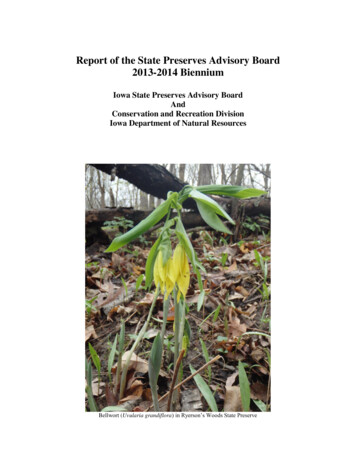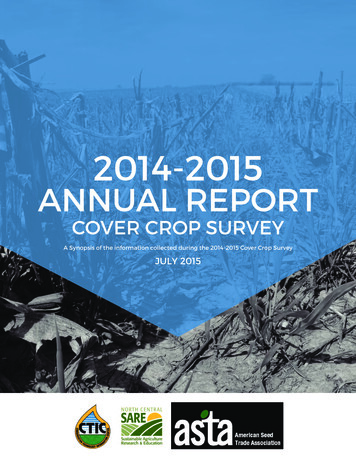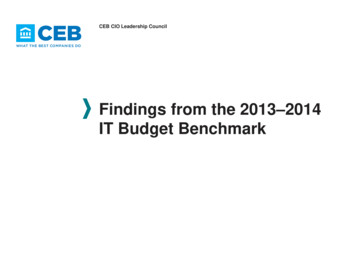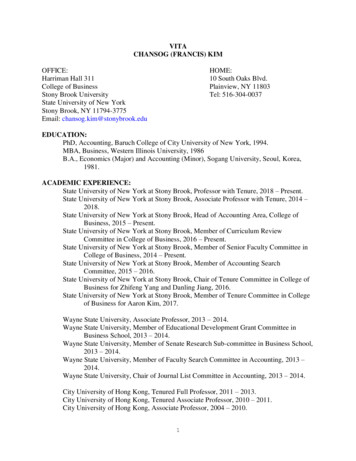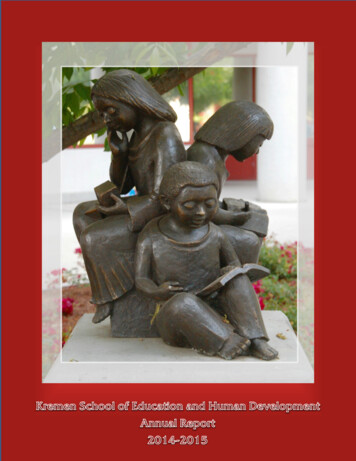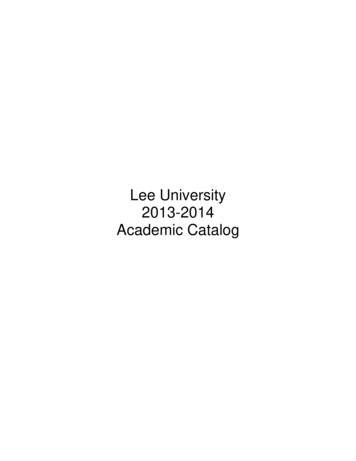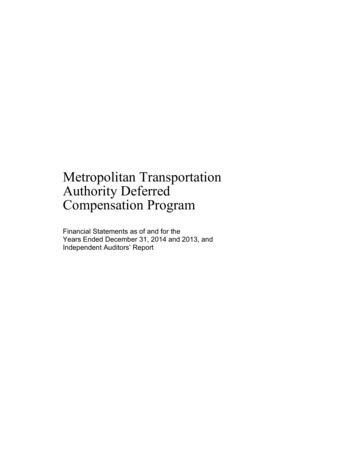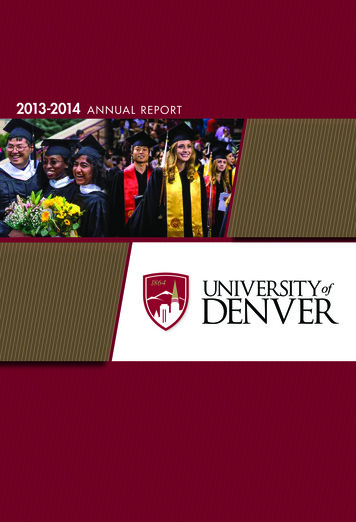
Transcription
2013-2014A N N UA L REP O RT
BOARD OF TRUSTEESDouglas G. Scrivner, JD ’77ChairRetired General CounselAccentureLos Altos Hills, CAEdward T. Anderson,BFA ‘71Founder and ManagingGeneral PartnerNorth Bridge VenturePartnersWaltham, MAJoy BurnsPresidentD.C. Burns Realty & Trust Co.DenverMargot Gilbert Frank, BA ’71TrusteeLewis D. and John J. GilbertFoundationDenverKevin Gallagher, MBA ’03President and CEOGallagher Industries LPDenverFrancisco GarciaManaging PartnerGarcia InternationalDenverPeter Gilbertson, BA ’75Chairman, President andCEOAnacostia & Pacific Co. Inc.ChicagoJames GriesemerProfessor and Dean EmeritusDirector, Strategic IssuesProgramDenverPatrick Hamill, BSBA ’81President and OwnerOakwood Homes, LLCDenverJane HamiltonFrederic C. Hamilton FamilyFoundationDenverRichard KelleyChairman of the BoardOutrigger EnterprisesDenverPat LivingstonRetired PresidentConstruction Technology Inc.DenverJohn Low, JD ’51Member/AttorneySherman and HowardDenverOtto Tschudi, BSBA ’75PartnerThomas Weisel PartnersSan FranciscoDonna LynneExecutive Vice PresidentKaiser Foundation Hospitalsand Health Plan Inc.DenverClara VillarosaFounder and Former OwnerThe Hue-Man ExperienceNew YorkJohn MillerBSBA ’75, MBA ’76President and CEONorth American Corporationof IllinoisChicagoCarrie MorgridgeVice PresidentMorgridge Family FoundationDenverTrygve MyhrenPresidentMyhren Media Inc.DenverRalph NagelPresidentTop Rock Inc.DenverRobert NewmanOwnerGreenwood Gulch VenturesDenverDenise O’LearyPrivate InvestorDirector, Calpine Corp.,Medtronic Inc. and USAirways Inc.DenverScott Reiman, BSBA ’87PresidentHexagon InvestmentsDenverJoseph SaundersBSBA ’67, MBA ’68Former Chairman and CEOVisa Inc.San FranciscoCatherine ShopneckBFA ’76, MBA ’79PrincipalSouth Woods Financial LLCDenverDonald Sturm, LLB ’58Chief Executive OfficerThe Sturm GroupDenverFrederick Waldeck, BSBA ’71Managing DirectorTishman SpeyerDenverHONORARY LIFETRUSTEESWilliam K. CoorsEdward W. EstlowWilliam C. KurtzEdward LehmanDaniel L. Ritchie, ChancellorEmeritusJohn J. SieJ. William SorensenRobert K. TimothyCarl M. WilliamsADMINISTRATIONRebecca S. ChoppChancellorGregg KvistadExecutive Vice Chancellorand ProvostPeg Bradley-DoppesVice Chancellor for Athletics,Recreation & Ritchie CenterOperationsKevin A. CarrollVice Chancellorfor Marketing &Communications, ChiefMarketing OfficerPaul ChanVice Chancellor for LegalAffairs and General CounselDavid Ethan GreenbergVice Chancellor forInstitutional PartnershipsScott LumpkinVice Chancellor forUniversity AdvancementThomas WilloughbyVice Chancellor forEnrollmentCraig WoodyVice Chancellor for Businessand Financial Affairs,TreasurerNancy AllenDean, University LibrariesE. LaBrent ChriteDean, Daniels College ofBusinessLynn GangoneDean, Colorado Women’sCollegeChristopher HillDean, Josef Korbel School ofInternational StudiesMartin KatzDean, Sturm College of LawMichael KeablesInterim Dean, Daniel FelixRitchie School of Engineeringand Computer ScienceAndrei KutateladzeDean, Division of NaturalSciences and MathematicsMichael McGuireDean, University CollegeDaniel McIntoshDean, Divisions of Arts,Humanities and SocialSciencesKaren RileyDean, Morgridge College ofEducationShelly Smith-AcunaDean, Graduate School ofProfessional PsychologyJames Herbert WilliamsDean, Graduate School ofSocial Work
Contents2013-2014 ANNUAL REPORT4Letter From The Chancellor5Letter From The Chair6Public Good: Demystifying Human Diseases8Public Good: Dialogue Across Borders And Time Zones10Public Good: Mapping History12Public Good: Collaborating Across Disciplines14Preparing The University For Changing Times16Introducing New Leaders For Changing Times18ASCEND: The Campaign For The University Of Denver20Celebrating Our Sesquicentennial22Awards And Honors24Growth In Assets And Endowment26Investment In Strategic Goals28Faculty Population30Student Profile2 0 1 3 - 2 0 1 4A N N U A LR E P O R T3
LetterFROM THE CHANCELLORThe stories shared within this annual report—stories of ambitious scholarship, of students inpursuit of passions, of a well-managed institution—are part of the reason why, in June 2014,I accepted the offer to serve as the University of Denver’s 18th chancellor.As someone who is deeply committed to higher education’s transformative role in society,I’ve long been impressed with the University of Denver’s robust tradition of serving thepublic good, its impressive track record of building engagement and its perfect combinationof professional schools, graduate programs and undergraduate opportunities. This is thelegacy of outstanding leadership by my most recent predecessors, Robert D. Coombe andDaniel L. Ritchie.The intellectual energy of this country is increasingly powered by innovative institutionslike this one, and I am honored to lead the University at this important time in our history.I’m especially excited about helping this institution support and expand the knowledgegenerated on our very own campus, by our very engaged community of students, staff andfaculty.This is an amazing time for education. In this era of globalization, constant change andclamor, we must work together to face challenges and opportunities. How do we maximizeand expand our intellectual and fiscal resources? How do we do more and do it better—more and better research, more and better outreach, more and better opportunities for ourincredible students? How do we prepare the leaders of the 21st century for the professions,for innovation and for civic engagement?Fortunately, the University of Denver is no stranger to transforming challenges intoopportunities. In fact, as this year’s sesquicentennial celebration has reminded us, our talentfor combining our aspirations with our resourcefulness has always allowed us to create andseize opportunities. And there’s more to come.In the months ahead, I hope you will share with me your ideas for the University’s future.And then together with others who care about DU, we’ll work to bring those big dreams intoa transformative vision for the sake of future students and for the sake of serving Denver, ourcountry and our world.Rebecca S. ChoppChancellor4
LetterFROM THE CHAIRAs our year of sesquicentennial celebrations comes to a close, it is my pleasure to assumethe chair of the University of Denver Board of Trustees.This has been a remarkable year, full of celebration, reflection, accomplishment andchange. Much of the history of the University has been about stories of its leadership, ingood times and bad. Robert D. Coombe made enormous contributions, during his nine yearsas chancellor, to the academic quality of the institution, and of our faculty and students,as well as through his financial stewardship and his leadership of the ASCEND campaign.Trygve Myhren, my predecessor as chair, provided a steady hand and an eye on the futurein his leadership of the board and the University as a whole. Many thanks to both Bob andTryg, who have richly earned their new titles as chancellor emeritus and chairman emeritus,respectively.Reflecting on the University’s history gives us the opportunity not just to celebrate pastaccomplishments but also to learn from the past and to discern what elements from ourhistory should endure as we plot our future course—particularly given the “unsettling times”outlined by the Strategic Issues Program under James Griesemer’s leadership (see page 14).This University remains deeply rooted in Denver and the Rocky Mountain West, even as itsnational and international scope and impact expand greatly. I think of the resilience of theinstitution, its ability to change and to respond to new conditions, while remaining optimisticand looking forward, as defining characteristics of the University throughout its history.These values will help guide us as we take advantage of the opportunities and challengesahead. I look forward to working with Chancellor Rebecca Chopp and the entire Universityof Denver community as we define our future together.Douglas G. ScrivnerChairBoard of Trustees2 0 1 3 - 2 0 1 4A N N U A LR E P O R T5
Dedication6TO THE PUBLIC GOOD
GRADUATE STUDENT JOINS EFFORT TO DEMYSTIFYHUMAN DISEASESAt the University of Denver’s Eleanor RooseveltInstitute (ERI), founded in 1961 to conductpioneering biomedical and genetic research,undergraduate and graduate students partnerwith world-renowned scholars in a quest tounravel the mysteries of disease.For Nathan Duval, a PhD candidate in biologicalsciences, that quest has personal significance.“My mother has lupus,” he explained, so he iswell acquainted with the toll that disease takeson overall health and day-to-day life. “And I’minterested in disease processes—the idea thatcertain genetic mechanisms can cause disruptionsin your physiology and lead to disease.”While casting about for a graduate programthat would address two priorities—furtheringhis understanding of how diseases behaveand enhancing his career prospects inbiomedical research—Duval learned about thegroundbreaking work under way in the lab of theERI’s David Patterson. That, as well as the chanceto work with interdisciplinary research teams atthe ERI, convinced him to apply to the Universityof Denver.His decision has paid off in hands-onopportunity. He and Patterson are collaboratingon a handful of projects that could improvewhat Duval calls “the health-span” in peoplecontending with an array of genetic diseasesand disorders. What’s more, he has securedcredits as the first author on an article, publishedwith Patterson, in Molecular Genetics andMetabolism.Patterson, who holds the University’s TheodorePuck Endowed Chair, is known internationallyfor his decades of research on Down syndrome.In fact, his part in the mapping of chromosome21, which contains the blueprint for Downsyndrome, has added significantly to the scientificcommunity’s understanding of the geneticcondition.To advance that understanding even further,Patterson and Duval are working with the Ts65Dnmouse model of Down syndrome. The Ts65Dn isa genetically altered model for Down syndrome.“The mouse has a lot of features that are verysimilar to Down syndrome,” Patterson said. “Ithas learning and memory deficits and it hasskeletal differences. It also has a precursor ofleukemia. A lot of those things happen in peoplewith Down syndrome. It also ages differently,and that’s been our hypothesis for people withDown syndrome for a long time.”Using the Ts65Dn mouse model, Duval andPatterson are studying the metabolome andphysiological changes that accompany aging inDown syndrome. “We are trying to understandthe metabolomics, or changes in small moleculesand metabolites, that may be part of, or due to,the genetic and physiological alterations thataccompany Down syndrome and aging,” Duvalexplained.This quest has ramifications for scientists and, intime, the medical community. After all, the morethat scientists understand the pathways involvedin aging, the better able they’ll be to addresssuch health-span issues as deteriorating cognitionor muscular function.The work may even be applicable to the complexbut much-misunderstood autoimmune disease thattroubles Duval’s mother. “Lupus happens to bean aging-related disease, though not in the sensethat as you get older you are more susceptible,”Duval said. “Rather, lupus accelerates the rate ofaging. A person afflicted with lupus may appearnormal, but physiologically they are much older.”Like so much scientific research, this work willunfold over years. “A lot of it involves waitingwhile the mice get old,” Patterson said.Meanwhile, Duval appreciates the opportunityto be part of the ERI’s multidisciplinary work.“Understanding disease is not just a biologicalproblem,” he said. “Diseases need to beapproached from as many different angles aspossible to further our understanding.”2 0 1 3 - 2 0 1 4A N N U A LR E P O R T7
Dedication8TO THE PUBLIC GOOD
HISTORY-MAKING EVENT OPENS A DIALOGUE ACROSSBORDERS AND TIME ZONESIn February, more than 200 students, faculty andcommunity members came to the University’sAnderson Academic Commons to witness ahistoric conversation between Mohammad JavadZarif, minister of foreign affairs for the IslamicRepublic of Iran, and Christopher Hill, formerU.S. ambassador to Iraq and current dean of theJosef Korbel School of International Studies.Zarif is aKorbel Schoolalumnus (MA’84, PhD ’88)who also hasserved as Iran’sambassadorto the UnitedNations andthe country’sdeputy minister of foreign affairs.Hosted by the Josef Korbel School’s Centerfor Middle East Studies, the conversation—conducted via live web conference—coveredsuch topics as Iranian-U.S. relations; the crisis inSyria; internal human rights issues in Iran; andIranian-Israeli relations.The live discussion came at a critical juncture inIran-U.S. relations, just after the first day of P5 1negotiations in Vienna regarding Iran’s nuclearprogram.“From my perspective,” Zarif said, “I’m tryingto see how best we can achieve a goal that isshared both by Iran as well as by our negotiatingpartners. Now wehave a possibility tomake a change, andthis change will havean impact not onlyon how we deal withthe nuclear issue, buthow Iran will dealwith the West inparticular.”The event afforded the audience a rare chanceto hear directly from a member of the Iraniangovernment.“Today,” Hill said, “our students had a front-rowseat to history and the unparalleled opportunityto submit questions and listen in real time to oneof the key players on the global stage.”2 0 1 3 - 2 0 1 4A N N U A LR E P O R T9
Dedication10TO THE PUBLIC GOOD
DETERMINED TO MAKE A POSITIVE IMPACT, A CARTOGRAPHYLOVING PROFESSOR MAPS HISTORYThrough her books, newspaper articles andpublic lectures, Susan Schulten, chair of theUniversity’s Department of History, brings bygoneevents to life for audiences eager to make senseof both past and present.Since November 2010, Schulten has contributedcolumns to the New York Times’ four-year“Disunion” series, launched to explore the causes,events and consequences of the Civil War. Herposts have addressed everything from AbrahamLincoln’s decisive victory in the 1860 presidentialelection to the economic arguments for theemancipation of slaves.“The Civil War continues to be a source oftremendous interest for Americans,” Schulten said.“The challenge is to write brief stories that appealto a wide audience but also do justice to thewar’s complexity.”Schulten also demystifies history for readers ofThe New Republic. There, she shows how citymanagers in 1880s San Francisco pandered toanti-immigrant sentiment and responded to amoral panic by mapping vice—brothels, opiumdens and gambling houses—in Chinatown.Another article featured an artist whose senseof perspective revolutionized mapmaking duringWorld War II.In her most recent book, “Mapping the Nation:History and Cartography in Nineteenth-CenturyAmerica” (University of Chicago Press, 2012),Schulten examines the explosion of maps inAmerica. The book chronicles how variouscrises in the 19th century forced Americans andEuropeans to use maps for entirely new purposes.A companion website—mappingthenation.com—allows cartography and history lovers from allover the world to pore over the maps andexplore their terrain for themselves.“Mapping the Nation,” which appeared inpaperback in 2013, received the 2012 Norrisand Carol Hundley Award from the AmericanHistorical Association-Pacific Coast Branch(AHA-PCB). Given for the most distinguishedbook on any historical subject by a scholar inthe American or Canadian west, the award isthe highest honor bestowed by the AHA-PCB.Schulten also received the 2013 Western HistoryAssociation’s Oscar O. Winther Award for herarticle “The Civil War and the Origins of theColorado Territory,” which appeared in theWestern Historical Quarterly.In the last year alone, Schulten shared herinsights into Colorado’s history in a RockyMountain PBS Colorado Experience documentarychronicling the University of Denver’s evolution.She helped to design the permanent “Milestonesin Colorado Legal History” exhibit in the newRalph L. Carr Judicial Center in downtownDenver. And, at a presentation sponsored by theUniversity’s Bridges to the Future public lectureseries, Schulten described how the University wasfounded during a grave national secession crisis,just as the Gold Rush was waning.Whether she is digging deep into Coloradohistory or exploring the evolution of maps,Schulten aims to examine the links between pastand present. The quest to make sense of the past,she said, “never gets old.”2 0 1 3 - 2 0 1 4A N N U A LR E P O R T11
Dedication12TO THE PUBLIC GOOD
A CROSS-DISCIPLINARY TEAM COLLABORATES ON CIVILIANAPPLICATIONS FOR MILITARY TECHNOLOGYAt the Daniel Felix Ritchie School for Engineeringand Computer Science, undergraduate andgraduate students join their professors on designand development projects meant to solve realworld problems.For engineering graduate student Steve Conyersand undergraduate computer science major TomHamill, that meant pooling skill sets to create aprototype mobile self-leveling landing platformfor unmanned aerial vehicles (UAVs).The platform—which maywell net Conyers some billingon a patent—was developedunder a National ScienceFoundation grant awardedto the Ritchie School’sUnmanned Systems ResearchInstitute (DU2SRI), directed byKimon Valavanis, chairmanof the electrical and computerengineering department, and Matt Rutherford,assistant professor of computer science. TheUniversity shares the 2.3 million funding—aimedat supporting civilian applications for unmannedaerial systems—with California State University atLos Angeles.From the moment he first learned about theproject—led by Valavanis, Rutherford andresearch scientist Nikolaos Vitzilaios—Conyerswanted to share in the challenge. “I really likeworking on something from scratch and making itthe best it can be,” he said.The 3-foot-by-3-foot platform allows small UAVsto land, download data and possibly evenrecharge batteries before returning to the airfor further duty. The wheeled device climbs anddescends hills and, once it has parked, levels itsplatform so that UAVs can alight without mishap.According to Rutherford, the platform extends therange of those UAVs known as vertical takeoffand landing (VTOL) vehicles. “For VTOL aerialvehicles, the biggest challenge is that they can’tstay aloft for very long,” he said.Extended range leads to extended productivity.Say a UAV is tasked with monitoring an oilpipeline. If it can periodically land on theplatform to download urgent data—perhapsinformation calling attention to a leak—itcan return to the air quickly to patrol anotherstretch of pipeline.Meanwhile, theinformation canbe transmitted todecision makers whocan take action.Conyers reports thathe was eager to takeon the mechanicaldesign. “From the getgo, it was going to be a mechanically complexproject,” he said. “The self-leveling part of it wasgoing to be a big challenge.”Once Conyers knew his design was viable,Hamill was enlisted to develop the softwarefor crucial functions. His interest in embeddedsystems—computer systems dedicated to aspecific function within a larger mechanical orelectrical system—made him the ideal person forthe job.“This type of programming can be kind offrustrating,” Hamill said. “What I like about itis that every embedded solution is specific to aproblem.”The project’s next phase will involve doubling theplatform’s size—a task sure to present a host ofnew challenges for the interdisciplinary team.2 0 1 3 - 2 0 1 4A N N U A LR E P O R T13
Preparing14THE UNIVERSITY FOR CHANGING TIMES
A REPORT BY THE STRATEGIC ISSUES PROGRAMWith an eye on the many issues challenginghigher education’s economic, operationaland pedagogic models, the University ofDenver’s renowned Strategic Issues Program(SIP) completed a comprehensive reportanalyzing the challenges ahead and offeringfirm recommendations for crafting a strategicframework to guide decision making.Released in February 2014, “Unsettling Times:Higher Education in an Era of Change,” wascommissioned by Chancellor Robert Coombeand Board of Trustees Chairman Trygve Myhrento address everything from technologicalinnovation and changing demographics torising costs, declining affordability and newcompetitors.The 21-member panel behind the report waschaired by trustee James Griesemer, director ofthe SIP and dean emeritus of the Daniels Collegeof Business. The 64-page document urges theUniversity to build its strategy on several keycomponents: educational innovation, service tostakeholders, market orientation, documenteddifferentiation, demonstrated value, a culture ofmeasurement, and institutional flexibility.The report also identifies key priorities forthe University as it contends with a crowdedhigher education marketplace, rising costsand disruptive technologies. These include thefollowing:»» After assessing strengths, weaknessesand competitive position, the Universityand each of its academic units shoulddevelop a detailed strategy to address theopportunities and challenges presented bychanging times. These strategies shouldinform resource allocation.»» The University should undertake anaggressive effort to differentiate itself andeach of its units in a clear and verifiablemanner.»» To differentiate itself, the Universityshould increase its efforts to integrateundergraduate and professional graduateeducation programs. It also must continueto develop educational experiencescentered on understanding, applying andcreating knowledge in ways that provide afoundation for insight, critical judgment andoriginality.»» The University’s primary focus should beon creating academic and professionalvalue for students. The University shouldconsistently verify the value created byits programs. Programs failing to createdemonstrably high levels of value should berevitalized or terminated.»» In support of timely and informed decisionmaking, two hallmarks of institutionalflexibility, the University should examine—and if necessary adjust—its governanceand operating policies.»» The University should increase itsfundraising activities for endowment, andfundraising should become an integral partof the institution’s culture.The full report can be reviewed atwww.du.edu/issues/.2 0 1 3 - 2 0 1 4A N N U A LR E P O R T15
IntroducingNEW LEADERS FOR CHANGING TIMESREBECCA S. CHOPPThe University of Denver’s 18th ChancellorOn June 12, the University of Denver announcedthe selection of Rebecca Chopp as its nextchancellor.The first woman to hold the University’s topposition, Chopp, 62, brings to the post morethan 20 years of experience in higher educationleadership: as president of Swarthmore Collegeand Colgate University, as dean of the YaleDivinity School, and as provost and executivevice president for academic affairs at EmoryUniversity.“Dr. Chopp is a distinguished scholar andacademic leader who has taken two top-20liberal arts colleges through the development ofstrategic plans that positioned those institutionsto navigate through the complex challengesfacing higher education today,” said DouglasScrivner, chair of the search committee.“University members—including student leaders,faculty, administration, staff, alumni andtrustees—who participated in the final interviewswere uniform in their enthusiastic support of Dr.Chopp. All of this made her the right selectionfor DU at this time in our history.”Chopp also is a well-known scholar ofprogressive religious movements in Americanculture. Her recent work has focused onchanging structures and cultures in highereducation, on the role of liberal arts in ademocratic society, and on religion and highereducation. She is the author or editor of sixbooks, including “The Praxis of Suffering:An Interpretation of Liberation and PoliticalTheologies” (1986); “The Power to Speak:Feminism, Language, God” (1989); and“Remaking College: Innovation and the LiberalArts” (2013).16A native of Kansas, Chopp earned a bachelor ofarts from Kansas Wesleyan University, a masterof divinity from St. Paul School of Theology anda PhD from the University of Chicago.In an interview with the University of DenverMagazine, Chopp attributed her interest inthe University to what she called its “amazingattitude.”“I’ve learned in the interviews for thechancellor’s position that DU’s forward-lookingattitude is best described with words such asoptimism, resiliency, creativity, engagement,energy and courage,” she said. “ Every singleperson I met in the interview process—students,staff, faculty, alumni and trustees—expressedthose attributes in their love and dreams andcommitment to this institution. The attitude of aninstitution determines, I think, its culture, its abilityto seize opportunities, its handling of adversity,and the nature of its environment for learningand development of students.”
DOUGLAS G. SCRIVNERChair of the Board of TrusteesAlumnus Douglas Scrivner (JD ’77), a Universityof Denver trustee since 2008, assumed thetop leadership post on the institution’s boardbeginning July 1, 2014.Scrivner’s extensive professional backgroundand decades of community leadership givehim the diverse experiences needed to overseea Board of Trustees charged with helping theUniversity navigate the ups and downs of acomplex higher education marketplace.Scrivner retired from Accenture in 2011 after 31years with the global management-consulting,technology-services and outsourcing company.As the corporation’s general counsel, a post heheld for 14 years, Scrivner built a legal group ofmore than 400 lawyers in 35 countries. He alsooversaw the company’s government relationsand served as corporate secretary, complianceofficer and as a member of Accenture’sexecutive leadership team. During his tenure,the firm went from 2,000 employees and 220million in revenue to 230,000 employees and 25 billion in revenue.At the University, Scrivner has played a vastarray of roles. For years, he made weekly flightsfrom his California home to teach corporategovernance risk and compliance at the SturmCollege of Law. He also chaired the SturmCollege of Law’s visiting committee and cochaired its Second Century Campaign.Outside of the University, Scrivner has lent histalents and time to the Gladstone FoundationBoard, which supports the research of the SanFrancisco-based Gladstone Institutes, and theDiversity and Flexibility Alliance, an initiative tohelp law firms and law departments attract andretain female lawyers. He also provides fundsto a Saturday law academy for underprivilegedCalifornia ninth-graders.Scrivner has given back to the University withgenerosity and countless hours of service. In2012, he and his wife, Mary, made a sizablegift to the Anderson Academic Commons tofund the Front Porch Café, a gathering placethat honors his parents and the home he grewup in. The couple also provided initial fundingfor the Sturm College’s Ved Nanda Center forInternational Law.Scrivner is a recent recipient of the John EvansAward, the University’s highest alumni honor,commemorating his countless hours of serviceand generosity to the University.2 0 1 3 - 2 0 1 4A N N U A LR E P O R T17
ASCENDTHE CAMPAIGN FOR THE UNIVERSITY OF DENVERASCEND: The Campaign for the University ofDenver concluded on June 30, 2014, as the mostsuccessful fundraising campaign in Universityhistory. The generosity of more than 48,000alumni and friends who gave a total of nearly 490 million has enhanced the educationalexperience for students and strengthened theUniversity for the long term.Support for scholarships was a hallmark of thecampaign. Donors’ generosity created nearly600 new scholarships and nearly doubled thenumber of endowed scholarships establishedpreviously.Gifts to the campaign reached all aspects ofthe University, including innovative centers ininternational studies and in law, professorshipsin painting and in Italian culture, and faculty andprograms in education, as well as programs inpre-med research and finance.18The campus transformation continued witha new home for the Morgridge College ofEducation, student art studios and a LEED Goldrated residence hall, to name just a few. TheAnderson Academic Commons, a library formodern learning, was made possible throughthe generosity of more than 5,000 donors. Thecoming years will bring a new complex for theJosef Korbel School of International Studies anda new home for the Daniel Felix Ritchie Schoolof Engineering and Computer Science and theKnoebel Center for the Study of Aging.During the course of the eight-year campaign,the University’s endowment more than doubledto exceed 460 million. The strong endowmentindicates significant stability as the Universityanticipates the opportunities of the comingdecades.
WHO GAVE?48,290Total Number of ASCEND Donors26,522First-Time Donors During ASCEND8,773First-Time Donors During ASCENDWho Became Repeat DonorsWHERE ARE THEY FROM?25,231Total Number of Colorado Donors22,63852%Total Number U.S. (non-Colorado) Donors421Total Number of Non-U.S. Donors(from 49 countries)A LITTLE GOES A LONG WAY.72,186Number of Gifts of Less Than 100 3.7 MILLIONTotal Funds Raised From These Gifts2 0 1 3 - 2 0 1 4A N N U A LR E P O R T19
Celebrating20OUR SESQUICENTENNIAL
150 YEARS YOUNGThe University kicked off a year’s worth of150th anniversary festivities in early January.The birthday bash began with the openingof an extensive commemorative exhibit andwill conclude in late October with a specialHomecoming and Family Weekend.“Tradition and Legacy”—an interactive exhibitthat will run throughout the year—features13 stations spread throughout all three floorsof the Anderson Academic Commons. Theexhibit covers everything from campus life andcommunity service to athletics and performingarts. In addition to large banners that tell theUniversity’s story in words and pictures, manystations also include cases full of artifacts—from vintage cheerleading uniforms toCommencement scepters and school beanies.Winter Carnival, a University of Denver studenttradition for 53 y
and Health Plan Inc. Denver John Miller BSBA '75, MBA '76 President and CEO North American Corporation of Illinois Chicago Carrie Morgridge Vice President Morgridge Family Foundation Denver Trygve Myhren President Myhren Media Inc. Denver Ralph Nagel President Top Rock Inc. Denver Robert Newman Owner Greenwood Gulch Ventures Denver Denise O .


